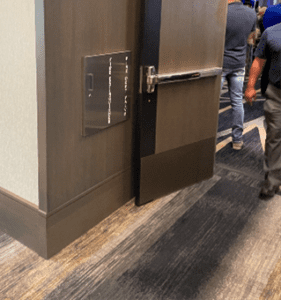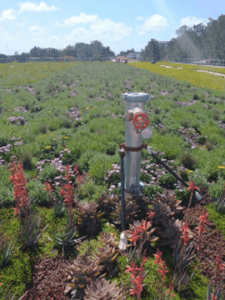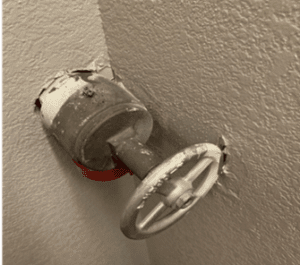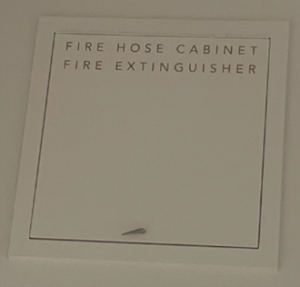Did you Know? Clearances – Standpipe Hose Connections

By Terin Hopkins, Manager of Public Fire Protection
Did you know?
Clearances – Standpipe Hose Connections
Standpipe hose connections are often hidden in buildings, installed too high/low or behind doors making access in an emergency challenging. While some of the requirements have been in the standard for many years, the 2024 edition of NFPA 14 Standard for the Installation of Standpipes and Hose Systems clarified the need to make these critical connections more visible.
During the 2019-2024 cycle of NFPA 14 a technical committee task group was convened to review and make some recommendations clarifying proper installation.
Many of the current requirements for clearance and installation were confirmed and maintained unchanged in the new 2024 edition but several new requirements were added for clarification.
Unchanged requirements in NFPA 14:
- Valve height remained at 3 feet (900mm) – 5 feet (1.5m) above the floor.
- Measured to the center of the valve.
- Shall not be obstructed.

New 2024 requirements for NFPA 14:
- Horizontal exit hose connections shall be visible and within 20 feet of each side of the exit. This requirement is to make sure hose connections are within a reasonable distance from the door, and visible. This section also added new language prohibiting hose connections from being obstructed by a closed or open door(s).

2. Hose connections are now required on occupiable, landscaped roofs and must meet the travel distance of 130 feet (40m). We continue to see roofs used as occupiable space and this requirement adds hose connections, based on travel distance of an un-sprinklered area.

3. The hose connection handle must have 3 in. (75mm) of clearance between any and all adjacent objects. This clearance is based on a firefighter’s gloved hand and includes the movement of the handle, ranging from closed to fully open. The clearance requirement would apply to hose connection in or outside of a cabinet.

4. Access panels – sized for clearances, marked, meeting appropriate fire resistance ratings with locks, handles, and latches all being acceptable to the authority having jurisdiction (AHJ). This was done for clarity that cabinets, doors, locks, and latches are visible, accessible, and acceptable to the AHJ and allow for needed firefighter access.

Understanding the installation requirements for clearance and accessibility of standpipe hose connections will greatly enhance fire service operations during an emergency and provides a higher level of life safety and building protection.
More about the Author:
 Terin Hopkins has 34 years of experience in public safety and is currently the Manager of Public Fire Protection for the National Fire Sprinkler Association. He represents NFSA on many NFPA and UL technical committees, including NFPA 14 for Standpipes.
Terin Hopkins has 34 years of experience in public safety and is currently the Manager of Public Fire Protection for the National Fire Sprinkler Association. He represents NFSA on many NFPA and UL technical committees, including NFPA 14 for Standpipes.
Have a Question About Codes or Standards? Contact the NFSA Today!
Members and employees of NFSA work very closely in the codes and standards development process. Our team of experts stays on the cutting edge of fire protection issues by participating in over 250 codes and standards development committees.
NFSA members benefit from the association’s involvement in the code development process through a service called Expert of the Day. This service provides members with an answer to even the most difficult codes and standards question.
Additionally, the NFSA’s Expert of the Day Handbooks are a great resource for fire sprinkler contractors, layout technicians, engineers, authorities having jurisdiction, inspectors, and students, and serve as a compilation of the best Expert of the Day Questions going back decades.
If you have an interest in NFSA’s mission to protect lives and property through the widespread acceptance of the fire sprinkler concept, or you simply want to get more involved in the codes and standards process with NFSA, please visit NFSA’s membership page.
